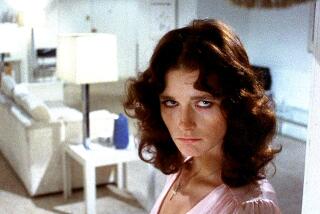A Second Look: John Cassavetes’ touch is clear in ‘Too Late Blues’
Independence is a crucial part of the legend of John Cassavetes, the original Method actor turned DIY filmmaker. For that reason his early forays into studio directing — he made 1961’s “Too Late Blues” for Paramount and 1963’s Stanley Kramer-produced “A Child Is Waiting” for United Artists — are usually thought of as footnotes at best, or compromised failures at worst (a view that has been ascribed to Cassavetes himself).
But even in these minor works, the Cassavetes touch — the delicate way of handling emotional messiness, the tough but ultimately generous view of human behavior — is unmistakable. The rarely seen “Too Late Blues,” new to DVD from Olive Films, is an especially resonant work, a parable about the price of artistic independence and the conflicts of ego and idealism — in other words, something like a confessional manifesto from the emerging director, 31 when he made it.
Cassavetes’ first film, “Shadows” (1959), was groundbreaking, and not just for being the story of an interracial romance, shot on location in the bohemian quarters of New York City with a largely nonprofessional cast — few other films have so completely changed the face of American cinema. Unlike its French counterpart,Jean-Luc Godard’s “Breathless,” “Shadows” did not launch a new wave, but its urgency and freshness became synonymous with the spirit of American independent film, manifest in era-defining works over the years from “Mean Streets” to “Stranger Than Paradise.”
Like “Shadows” (available in Criterion’s five-film Cassavetes boxed set) and “Johnny Staccato,” the short-lived private-eye TV series (1959-’60) that starred Cassavetes, “Too Late Blues” is set in the nocturnal jazz-music world. Cassavetes co-wrote the screenplay of this second directorial effort, with Richard Carr, a writer on “Johnny Staccato.”
The anguished hero, John “Ghost”Wakefield (Bobby Darin), is the pianist leader of a jazz ensemble whose members pride themselves on playing “what we want to play,” even if that also means playing in empty parks and old folks homes. Things begin to look up when a producer shows interest, and when Ghost starts dating Jess (Stella Stevens), a fragile aspiring singer whom he pries away from the sleazy clutches of his agent (Everett Chambers, a producer of “Johnny Staccato” and later “Columbo,” in an indelible, cold-eyed performance).
But one bad night in a bar — an absorbing 20-minute sequence that amply displays Cassavetes’ gift for generating scenes rife with contradictory cross-currents of emotion and psychology — brings all of Ghost’s insecurities to a head, leading to a painful break with Jess and the band. Before long he’s working the easy-listening lounge circuit and trapped in a perverse relationship as the kept boy toy of an aging socialite.
Cassavetes had to make a few compromises on “Too Late Blues,” though the experience was, by all accounts, not as traumatic as on “A Child Is Waiting,” which was taken away from him at the editing stage. His main concession, apart from a rushed schedule, was in casting — for the lead roles he had envisioned Montgomery Clift and Gena Rowlands, his wife and regular leading lady, a pair of actors who surely would have been sensational together.
But the studio’s choices were more than respectable: Darin is a surprise in his first nonsinging role, willing to appear both arrogant and weak, and Stevens, a sex symbol and underappreciated actress, proves her range and nerve. The cast also includes Cassavetes’ friend and frequent collaborator Seymour Cassel.
Much has been made of the link between jazz and Cassavetes’ modernist, seemingly free-form cinema, and the connection was obvious in the early days. “Shadows” used a Charles Mingus score and the terrific music in “Too Late Blues,” scored by David Raksin, was performed by jazz greats including Benny Carter.
All the talk in “Too Late Blues” of integrity and authenticity seems even more significant in light of the career Cassavetes went on to forge. Despite a certain mannered slickness, the film is proof of his inability, even under clear constraints, to make anything less than a deeply personal work.
After “A Child Is Waiting” he spent the next few years acting — his return to filmmaking, with”Faces”(1968), a film made completely on his own terms, marked his reinvention as an independent artist, and it kicked off a remarkable run (five more self-financed films, up until 1977’s “Opening Night”) unlike anything in American movies before or since.
More to Read
The biggest entertainment stories
Get our big stories about Hollywood, film, television, music, arts, culture and more right in your inbox as soon as they publish.
You may occasionally receive promotional content from the Los Angeles Times.










